
Don’t Lose Your Water Security
Dams play a critical role in water resource management, providing water for irrigation, drinking, power generation, and other essential needs. However, one of the major challenges dams face is evaporation, which leads to significant water losses over time. As climate change and water scarcity become more pressing concerns, it’s essential to adopt strategies that minimize evaporation losses from dams. In this article, we’ll explore eight effective ways to tackle this issue and optimize the water storage capacity of dams.
1. Floating Covers and Ballast Systems
Floating covers are innovative solutions designed to reduce evaporation losses by creating a barrier between the water surface and the atmosphere. These covers are typically made of geomembrane materials that are impermeable to water and resistant to UV radiation. Ballast systems keep the covers in place, ensuring they remain effective even during windy conditions.
Floating covers not only reduce evaporation but also help control algae growth and prevent contamination. These systems can significantly minimize water loss while also improving water quality.
2. Windbreaks and Vegetative Barriers
Wind is a major contributor to evaporation losses from dams. Planting windbreaks and vegetative barriers around the dam’s perimeter can create a natural shield against wind-driven evaporation. Trees, shrubs, and other vegetation help disrupt the airflow, reducing the rate of water vapor loss from the dam’s surface.
Strategically planting windbreaks not only reduces evaporation but also enhances the overall ecological health of the area, providing habitat for wildlife and preventing soil erosion.
3. Monolayer and Biodegradable Films
Monolayer and biodegradable films are thin layers that can be spread over the water surface to minimize evaporation. These films create a physical barrier that reduces the contact between water and the atmosphere, limiting water vapor escape. Monolayer films are made of materials that float on the water’s surface, while biodegradable films eventually break down without harming the environment.
Both types of films are easy to apply and can be a cost-effective solution for minimizing evaporation losses, particularly in areas with high evaporation rates.
4. Chemical Monolayers
Certain chemical compounds, known as monomolecular films or monolayers, can be spread across the water surface to create a thin layer that reduces evaporation. These compounds create a molecular barrier that inhibits water molecules from escaping into the atmosphere.
While chemical monolayers can be effective in reducing evaporation losses, it’s essential to carefully consider their environmental impact and potential interactions with aquatic ecosystems.
5. Shade Structures
Creating shade over the water surface is a straightforward yet effective strategy to reduce evaporation. Shade structures can be installed using materials like shade cloth or solar panels, which provide dual benefits of reducing evaporation and generating renewable energy.
Shade structures not only reduce evaporation but also help regulate water temperature, which can have additional benefits for aquatic ecosystems and water quality.
6. Mechanical Mixers and Aeration Systems
Stratification of water in dams can lead to increased evaporation rates, as warmer surface water is more prone to vaporization. Mechanical mixers and aeration systems can help prevent stratification by circulating the water and maintaining a more uniform temperature profile.
By keeping the water mixed, these systems help reduce the temperature difference between the surface and the deeper layers, thereby minimizing evaporation losses.
7. Evaporation Suppression Chemicals
Certain chemicals can be added to the water to suppress evaporation. These chemicals create a film on the water surface that reduces water vapor transmission. Calcium magnesium acetate, for example, is an environmentally friendly option that can effectively reduce evaporation losses.
However, it’s crucial to carefully assess the potential ecological and water quality impacts of using evaporation suppression chemicals before their application.
8. Water Management and Conservation Practices
Ultimately, one of the most effective ways to minimize evaporation losses is through responsible water management and conservation practices. Implementing efficient irrigation methods, reducing leaks, and optimizing water usage can significantly reduce the demand for stored water, ultimately leading to fewer losses through evaporation.
Additionally, regularly monitoring water levels, weather patterns, and evaporation rates can help you make informed decisions about when to release water, ensuring optimal utilization of water resources.
Conclusion
As the global demand for water continues to rise and the effects of climate change become more pronounced, it’s crucial to implement strategies that minimize evaporation losses from dams. By embracing innovative solutions like floating covers, windbreaks, films, and chemical treatments, along with practicing effective water management and conservation, we can ensure that our precious water resources are utilized efficiently and sustainably. Each of these strategies offers a unique approach to tackling evaporation, and their combined implementation can contribute to a more resilient and water-secure future.
More reading
4 Best Methods to Estimate Evaporation Levels in Semi-Arid Areas

Pingback: 15 Proven Water Conservation Methods Farmers Use to Beat Drought in 2025 - News TNW
Pingback: 10 Tips For Erosion Control Measures For Farm Dams | Big Ditch Dam Building Company